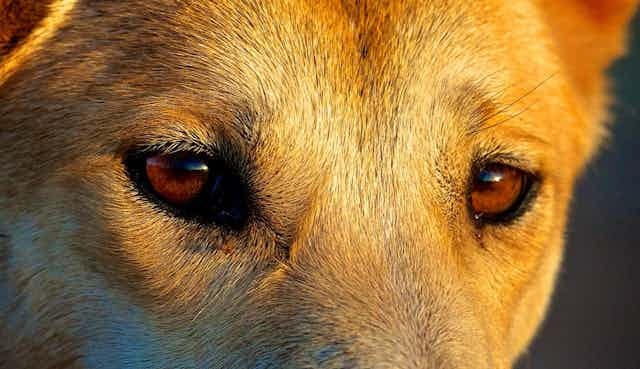On any given night, many farmers go to sleep worrying about what they might wake up to in the morning. Few things are more stressful than seeing your livestock, such as sheep, lying dead or seriously injured in the paddock. Sometimes dingoes, free roaming and unowned (“feral”) dogs, and domestic dogs, or their hybrids, are responsible for such a scene. But what’s the best way to deal with this situation?
The Victorian government is set to reinstate a dingo and wild dog bounty scheme as a way to reduce livestock, especially sheep, being attacked and killed, in response to calls from farming and shooting groups.
Just what is a dingo?
One of the problems with managing dingoes is that the boundary between them and “wild dogs” is contentious. Some have even claimed that there are no pure dingoes in Victoria.
Defining what dingoes are is harder than you might think. There is considerable variation in how dingoes look, for example, in terms of their overall size and colour, as is common with many other members of the dog family (canids).
And if a dingo isn’t considered 100% “pure”, containing genes from domestic dogs, should hybrids be managed differently to dingoes?
Research suggests “pure” dingoes do exist in Victoria, albeit in smaller numbers than other regions.
Notably though, genetic samples in Victoria have been collected largely from areas close to towns, where there are likely more hybrid dogs, and less so from deep within Victoria’s more remote natural regions (the mallee, alpine, and Gippsland forests), where dingoes are often sighted.
Two other recent studies are important in the Victorian context. One suggests dingo characteristics prevail even within hybrids and another has found there are two distinct dingo populations. Importantly, the south east dingo population is at increased risk of extinction.
Many ecologists would argue that splitting hairs about dingo genetic “purity” is a moot point, because what really matters is what dingoes and dingo-dog hybrids are doing in the environment. This is because dingoes are known to have important ecological roles, including the suppression of feral species (such as cats, pigs, and goats), red foxes, and kangaroos.
How are wild dogs and dingoes managed in Victoria?
The decision to reinstate a dingo and wild dog bounty in Victoria is vexed. In 2007 the Victorian government established protection of dingoes, due to conservation concerns about the species, with hybridisation between dingoes and domestic dogs identified as a threatening process.
As a result, dingoes in Victoria are listed as a threatened species under the Flora and Fauna Guarantee Act 1988 and protected under the Wildlife Act 1975.
In Victoria wild dogs are classed as pest animals and can be legally controlled. However, the Victorian Department of Environment states that “dingoes are visually indistinguishable from wild dogs, making it impossible to ensure they are not inadvertently destroyed in wild dog control programs in any given area where both exist” and “dingoes are protected wildlife and it is an offence under the Wildlife Act 1975 to take or kill protected wildlife without an authorisation to do so”.
Management misfire
Legal and species identification issues aside, do bounties and lethal control of predators actually work?
In short, scientific evidence suggests the answer is largely no (see for instance here, here, here, here, and here).

There are a range of reasons cited for why bounties fail. These include:
an inability to sufficiently reduce numbers of the the target species and hence their impact, due to rapid breeding and/or immigration from other areas
corruption by those claiming bounties, whereby animals claimed for bounty payments have not actually been killed in the area where the bounty is intended to benefit
an inability to access some animals over large and/or remote areas
a disincentive to completely eradicate animals as this removes the source of income
disruption of predator social structures causing higher livestock predation.
Investing in predator-friendly farming
So what solutions do we have that might allow productive farms without the need to kill predators? A range of nonlethal solutions exist for protecting livestock, including improved husbandry techniques (such as corralling and herding), and in particular, a growing body of research suggests guardian animals provide a great step forward.
Nonlethal methods to protect livestock are also consistent with a growing social demand that both domestic and wild animals are treated humanely and ethically on farms.

Predator-friendly farming is growing across Australia, as you can see in the image above. Large livestock on large landholdings, such as beef cattle on thousands of square kilometre stations, are reducing conflict by enabling dingo packs to stabilize and by supporting healthier cows that are better able to defend their calves (top left).
Smaller farms are also employing protective strategies, including guardian dogs, even if the livestock species is large, such as dairy cows and buffalo, because lethal control on neighboring farms continues to disrupt the dingo’s social structure (bottom left).
Technological innovations in nonlethal methods for protecting livestock from predators have been developed in Australia and used worldwide, such as “Foxlights” (top right). And vulnerable stock, such as chickens, are being successfully protected with guardian dogs and enclosures (bottom right).
There are substantial gains to be made for agriculture, people, wild animals and the environment if decision-makers use scientific evidence and ethical analysis, rather than responding to lobby groups, as the basis for taxpayer-sponsored actions.
Education is also a key aspect of any change, and scientists are being proactive here too, providing guidance on new approaches to rangeland livestock management that are supported by research.
The fact is, bounty schemes don’t work. If instead the substantial funds currently being invested in bounties were invested in supporting farmers to move to more long-term, cost-effective, and more environmentally-friendly solutions, we may all be able to sleep better at night.

